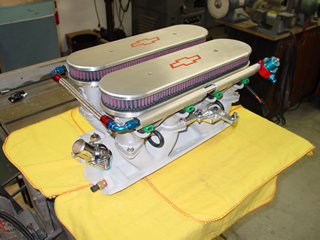Saturday Afternoon Status Report.
Okay. . . . Now I am really confused.
Made a minor adjustment. Started it up. Virtually no popping and no backfiring. Took it for a two mile drive through the subdivision. Accellerated smoothly to 3000 RPM (as fast as I care to go for fear of the neighbors wrath). Best it has ever run. So what happened?
Before going through the steps outlined in my post this morning, thought I would try one, simple, thing.
Every reference I have read (and I have read a bunch) indicates the idle mixture screw should be pre set between a half and one full turn out. Pat Braden say's a half turn, then add quarter turns incrementally. Red Line says if you end up with it out more than 1 1/2 turns it is too lean and if it is out only a half turn you are too rich. So that has been my starting point and frame of reference.
But Bob Tomlinson's book says something different. For IDF he says the mixture settings average 2 1/2 turns off bottom or perhaps even 3 1/2.
So just for laughs, I pre set the mixture screws out 2 full turns and the idle screw about a half turn after contact with the stop.
Fired it up. It is 40 degrees and humid today, so gave it time to warm up. Cylinder #8 was not firing, so opened the mixture up another half turn and set the idle screw out a bit slower, then it started firing. Engine was idling smoothly around 900 RPM
When just partially warmed up, there was no backfiring and very few spits. When fully warmed it continued to run as good as it has ever run.
So now what? Maybe the MSD has an intermittent issue and today was a good day. Perhaps I should leave it alone and start it tomarrow and if it runs like crap (as Ryan would say) we can assume it is indeed ignition.
But what if it keeps running reasonably well? Where do we go with tuning the carbs? Leave the idle jets alone or go bigger? Is the number turns out on the mixture screw really important as long as it runs right?
So much to learn . . . . .
Okay. . . . Now I am really confused.
Made a minor adjustment. Started it up. Virtually no popping and no backfiring. Took it for a two mile drive through the subdivision. Accellerated smoothly to 3000 RPM (as fast as I care to go for fear of the neighbors wrath). Best it has ever run. So what happened?
Before going through the steps outlined in my post this morning, thought I would try one, simple, thing.
Every reference I have read (and I have read a bunch) indicates the idle mixture screw should be pre set between a half and one full turn out. Pat Braden say's a half turn, then add quarter turns incrementally. Red Line says if you end up with it out more than 1 1/2 turns it is too lean and if it is out only a half turn you are too rich. So that has been my starting point and frame of reference.
But Bob Tomlinson's book says something different. For IDF he says the mixture settings average 2 1/2 turns off bottom or perhaps even 3 1/2.
So just for laughs, I pre set the mixture screws out 2 full turns and the idle screw about a half turn after contact with the stop.
Fired it up. It is 40 degrees and humid today, so gave it time to warm up. Cylinder #8 was not firing, so opened the mixture up another half turn and set the idle screw out a bit slower, then it started firing. Engine was idling smoothly around 900 RPM
When just partially warmed up, there was no backfiring and very few spits. When fully warmed it continued to run as good as it has ever run.
So now what? Maybe the MSD has an intermittent issue and today was a good day. Perhaps I should leave it alone and start it tomarrow and if it runs like crap (as Ryan would say) we can assume it is indeed ignition.
But what if it keeps running reasonably well? Where do we go with tuning the carbs? Leave the idle jets alone or go bigger? Is the number turns out on the mixture screw really important as long as it runs right?
So much to learn . . . . .


